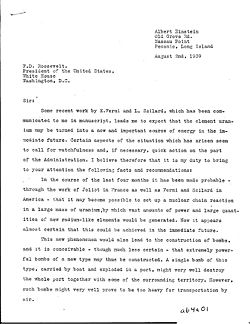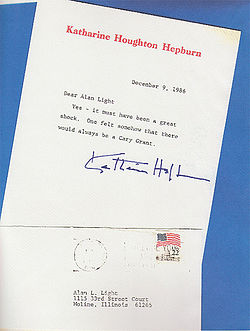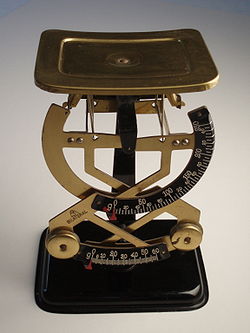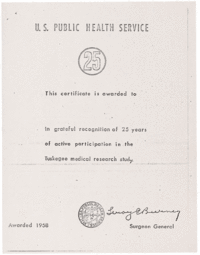- Letter (message)
-
 The famous Einstein letter from Edward Teller and Leó Szilárd to US President Franklin Roosevelt suggesting an atomic bomb project. Click here for page 2.
The famous Einstein letter from Edward Teller and Leó Szilárd to US President Franklin Roosevelt suggesting an atomic bomb project. Click here for page 2.
A letter is a written message from one party to another. The role of letters in communication has changed significantly since the nineteenth century. Historically, letters (in paper form) were the only reliable means of communication between two persons in different locations.
As communication technology has diversified, posted letters have become less important as a routine form of communication; they however still remain but in a modified form. For example, the development of the telegraph shortened the time taken to send a letter by transferring the letter as an electrical signal (for example in Morse code) between distant points. At the telegraph office closest to the destination of the letter, the signal was transferred back into a hardcopy format and sent as a normal mail to the person's home. This allowed the normal speed of communication to be drastically shortened for larger and larger distances. This required specialised technicians to encode and decode the letter. The facsimile (fax) machine took this one step further: an entire letter could be completely transferred electrically from the sender's house to the receiver's house by means of the telephone network as an image.
Today, the Internet is becoming (or has become) the predominant medium for sending letters. The term e-mail, meaning electronic mail, has entered into everyday speech. By analogy, the term letter is sometimes used for e-mail messages with a formal letter-like format. (And regular letters, since they take longer, are often called "snail-mail.")
Historically, letters exist from the time of ancient India, ancient Egypt and Sumer, through Rome, Greece and China, up to the present day. Letters make up several of the books of the Bible. Archives of correspondence, whether for personal, diplomatic, or business reasons, serve as primary sources for historians.
Contents
The Study of Letter Writing
Due to the timelessness and universality of letter writing, there is a wealth of letters and instructional materials (for example, manuals, as in the medieval ars dictaminis) on letter writing throughout history. The study of letter writing usually involves both the study of rhetoric and grammar.[1]
Advantages
 A thank-you letter from Katharine Hepburn to Alan Light thanking him for his condolences in regards of Cary Grant's death
A thank-you letter from Katharine Hepburn to Alan Light thanking him for his condolences in regards of Cary Grant's death
Letters are still used, particularly by law firms and businesses, for official (public) notifications, sometimes advertising. This is because of three main advantages:
- No special device needed - almost everybody has a residence or other place at which he or she can receive mail. A mailbox is all that the intended recipient needs - unlike e-mail or phone calls, where the intended recipient needs access to a computer and an e-mail account or a telephone respectively.
- "Catch-all" advertising- unlike e-mails, where the recipient needs an individual e-mail address to receive messages, individuals are not necessarily chosen, by rather can widely cover many or all addresses in a given locality.
- Physical record - important messages that need to be retained (e.g. invoices; government notification such as tax or immigration) can be kept relatively easily and securely.
The letter-delivering process
Here is how a letter gets from the sender to the recipient:
- Sender writes letter and places it in an envelope on which the recipient's address is written in the center front of the envelope. Sender ensures that the recipient's address includes the Zip or Postal (if applicable) code and often they include their return address on the envelope.
- Sender buys a postage stamp and attaches it to the front of the envelope on the top right corner on the front of the envelope.
- Sender puts the letter in a postbox and does nothing more.
- The national postal service for the sender's country (e.g., the Royal Mail, UK; US Postal Service, US; or Australia Post in Australia; or Canada Post in Canada) empties the postbox and takes all the contents to the regional sorting office.
- The sorting office then sorts each letter by address and postcode and delivers the letters belonging to a particular area to that area's post office. Letters belonging to a different region are sent to that region's sorting office, to be sorted further.
- The local post office dispatches the letters to their delivery personnel who deliver them to the appropriate addresses.
This whole process, depending on how far the sender is from the recipient, can take anywhere from a day to 3–4 weeks. International mail is sent via trains and planes to other countries.
Letter layout
United Kingdom, Canada, and Australia
The following is a common way to set out a letter:
Sender's address here 24 Lambert Street Stoke-on-Trent ST4 4WE Date here Formal: 7 November 2011 Informal: November 7 Recipient's name and address here Mr Boris Johnson 25 Lambkin Street Stoke-on-Trent ST3 9WR Main body Formal: Dear Sir or Madam, Acquaintance: Dear Mr Johnson, Informal: Dear Boris, Content Formal: Yours faithfully, Acquaintance: Yours sincerely, Informal: Best wishes, Sender's Name Formal: Sender's Occupation and Enclosures Informal: Nothing (optional: P.S. / Post Scriptum = Afterthought) United States
The following is the modified block format for a business letter, common in the United States:
November 7, 2011 Your Address
DateMrs. Jane Doe
25 First Street
Anytown, VA 10005Dear Ms. Doe:
This is an example of a modified block letter. The difference between it and a full block letter style is that the date begins at the center point of the page; therefore, if a letter has a 6 inch line of type, the date begins approximately over 3 inches from the left margin.
The closing block also begins half-way across the page. The complimentary close and the keyed signature (first and last name of the writer) begin at the same point as the date - approximately 3 inches from the left margin.
Sincerely, John SmithSales Representativejtp (the typist's initials appear at the left margin)
Thank you letter
A thank you letter or letter of thanks is a letter that is used when one party wishes to express appreciation to another party. There are two main types of thank you letters: business thank you letters and personal thank you letters.
Types
Business
There are numerous situations in day-to-day business that can warrant a thank you letter. Some typical situations include: appreciation for special consideration extended by another organization, thanking a speaker for a presentation at a board meeting, customer appreciation letters thanking customers for their patronage, thanks to employees for exceptional service or performance, thanks to an individual or organization for a customer referral, appreciation to volunteer service workers for their personal contributions to a public service campaign, etc.
Personal
As with business situations, there are many instances in day-to-day life that can warrant a formal thank you letter. Examples of typical personal thank you letter situations include: a follow-up thanks after a job interview or offer, thanks to a company or institution in appreciation for exceptional customer service received, letter to friends and/or neighbors for their support during a difficult period, letters for wedding gifts, thanks to a service club or agency for support given to family members, social occasion thank you letters for a wide variety of social situations, etc.
Format
A thank you letter should be written as a standard business letter or personal letter, and should not normally exceed one page. Personal thank you letters can be hand-written in cases in which the addressee is a friend, acquaintance or relative.
Thank you letters are also sometimes referred to as letters of gratitude. These types of thank you letters are usually written as formal business letters.
See also
- Address
- Carbon copy
- Compliments slip
- Envelope
- Historical documents
- Letter box
- Manuscript
- Pen pal
- Pony Express
- Post office
- Postage stamp
- Postmaster
- Postmaster General (disambiguation)
- Private Express Statutes
- Salutation
- Secrecy of letters
- Snail mail
- Stationery
- Typography
- Universal Postal Union
- Valediction
Types of letters
- Application letter
- Audio letter
- Begging letter
- Business letter
- Cease and desist letter
- Chain letter
- Cover letter
- Dear John letter
- E-mail letter
- Epistle
- Hate mail
- Introduction letter
- Letter of credence
- Letter of credit
References
- ^ Carol Poster and Linda C. Mitchell, eds., Letter-Writing Manuals and Instruction from Antiquity to the Present (Columbia, SC: U of South Carolina Press, 2007).
External links
Categories:- Letters (message)
- Paper products
- Postal system
Wikimedia Foundation. 2010.


